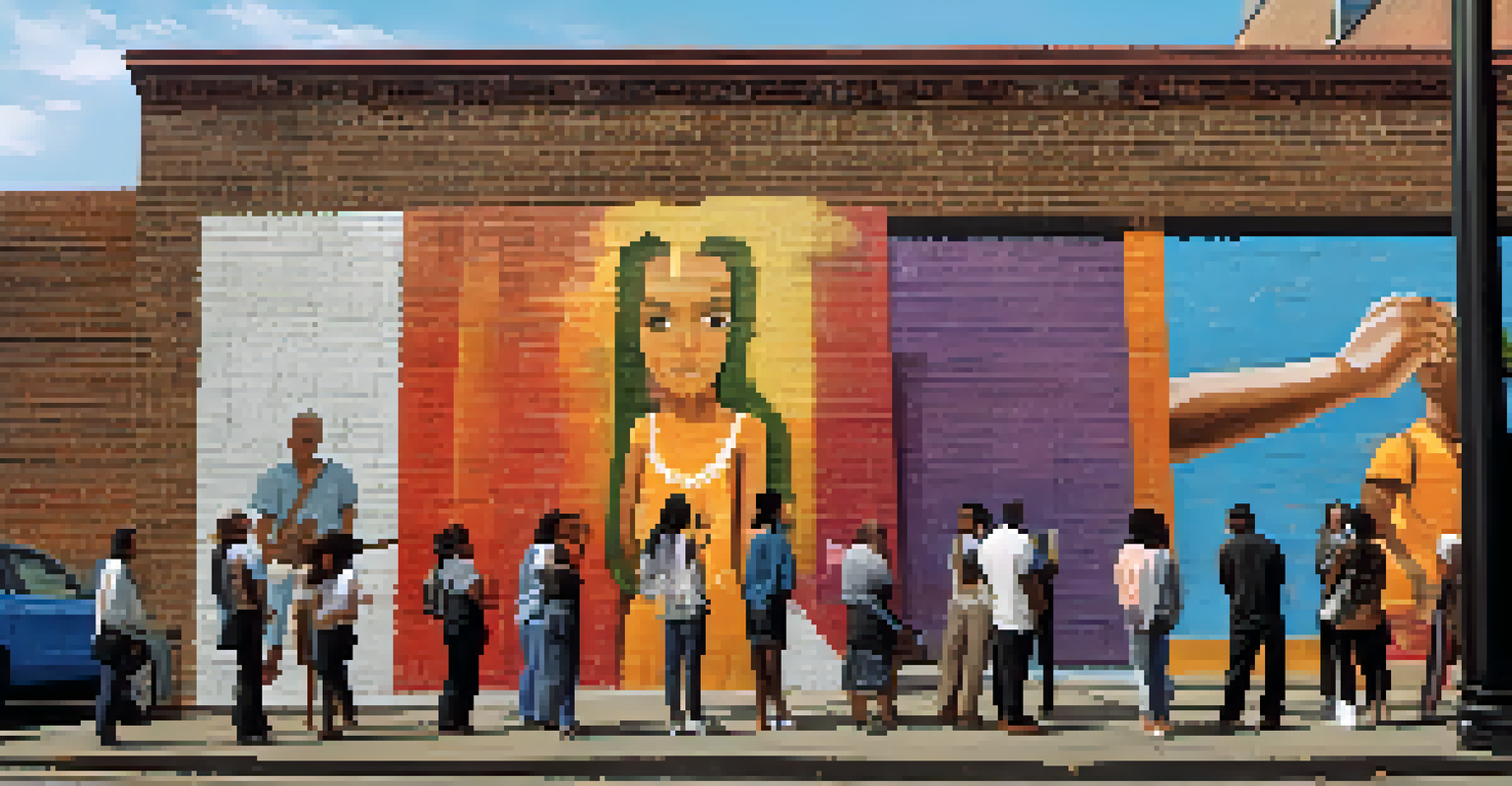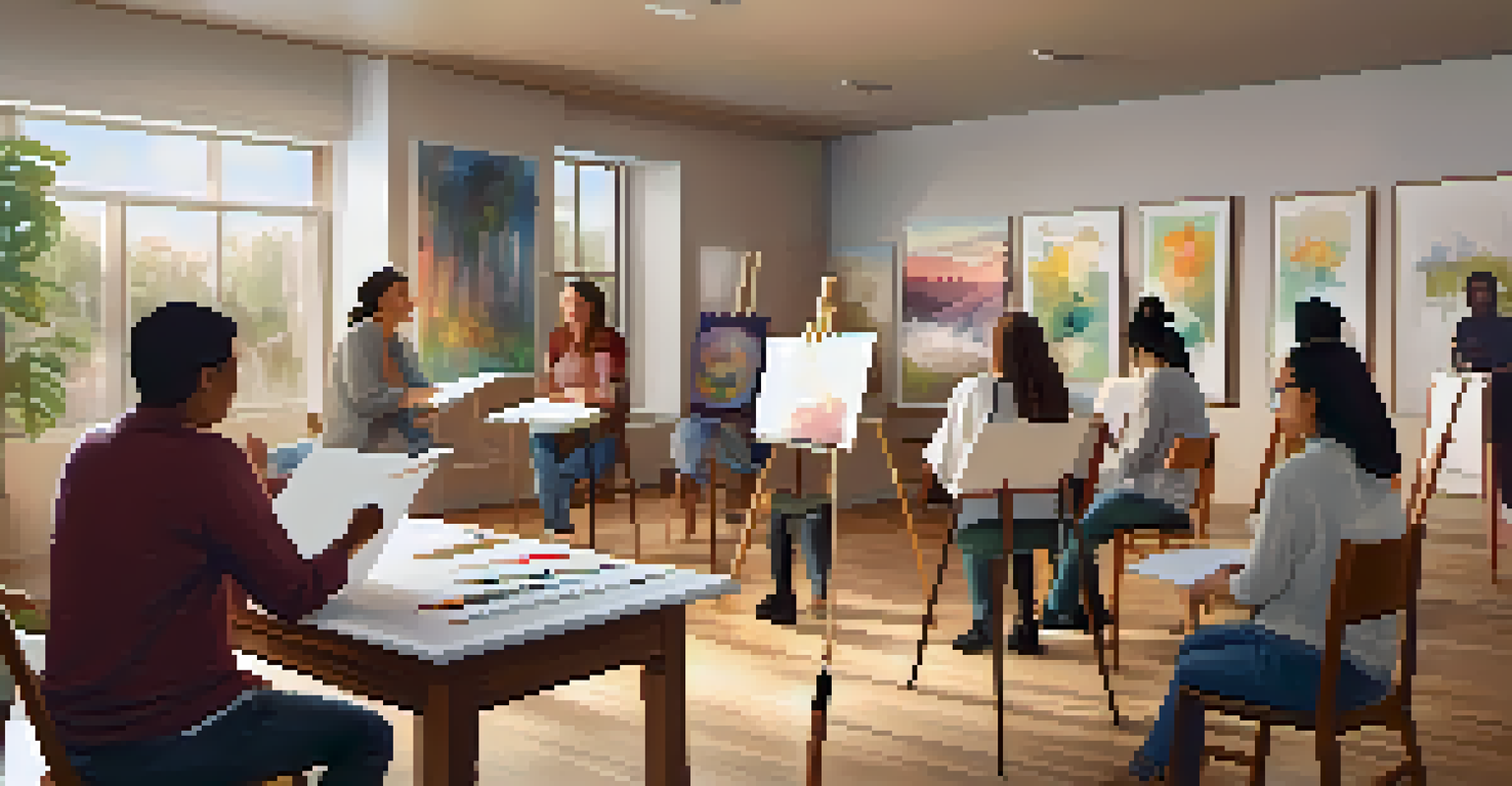Art and Empathy: Connecting Humanity Through Creative Expression

Understanding the Power of Art in Human Connection
Art has a unique ability to transcend barriers and connect individuals. Through various mediums like painting, music, and literature, people can express their emotions and experiences in ways that resonate with others. This shared understanding can foster a sense of belonging and community.
Art is the most beautiful of all lies.
When we engage with art, whether by creating or experiencing it, we tap into universal feelings and stories. For instance, a powerful song can evoke memories or emotions that are deeply personal yet widely relatable. This common ground helps us to see our shared humanity, reinforcing the idea that we are not alone in our struggles.
Ultimately, art serves as a bridge that connects diverse perspectives. By embracing different artistic expressions, we can cultivate empathy and appreciation for the rich tapestry of human experiences, making it easier to understand one another.
Art as a Tool for Empathy Development
Creating or experiencing art requires us to step outside of our own perspectives. This process encourages us to consider the feelings and experiences of others, which is a crucial aspect of empathy. For example, when a playwright portrays a character from a different background, it invites the audience to walk in that character's shoes.

Art workshops and collaborative projects can further enhance this empathetic connection. When individuals from varied backgrounds come together to create, they share their stories and learn from one another. This interaction often leads to a deeper understanding and appreciation of different life experiences.
Art Fosters Human Connection
Art transcends barriers, enabling individuals to express emotions and experiences that resonate with others.
Moreover, educational programs that incorporate art often promote emotional intelligence. Students who engage with art are frequently better equipped to recognize and express their feelings, as well as to understand those of others. This skill is invaluable in building compassionate communities.
The Role of Storytelling in Art and Empathy
Storytelling has been a fundamental part of human culture for centuries, and it is a critical element of art that fosters empathy. Through narratives, artists can convey complex emotions and experiences that resonate deeply with audiences. This connection often sparks conversations about shared human experiences.
The job of the artist is to deepen the mystery.
For instance, novels that tackle themes of loss, love, and struggle can create a profound emotional response. Readers may find themselves relating to characters’ journeys, prompting reflection on their own lives. This shared journey through storytelling can evoke empathy and encourage a deeper understanding of others.
Additionally, storytelling in art provides a safe space for individuals to express their vulnerabilities. By sharing their stories, artists not only validate their own experiences but also create platforms for others to voice theirs. This collective sharing can lead to healing and solidarity among diverse groups.
Art and Empathy in Social Movements
Throughout history, art has played a significant role in social movements, often serving as a catalyst for change. Artists use their craft to highlight injustices and rally people around a cause. This not only raises awareness but also fosters empathy towards those affected by societal issues.
For example, poignant murals in urban areas can convey messages about inequality and injustice. These visual statements invite passersby to pause and reflect, sparking conversations that might not happen otherwise. In this way, art becomes a powerful tool for social commentary and empathy-building.
Empathy Grows Through Creativity
Engaging in art encourages us to step outside our own perspectives, fostering a deeper understanding of others.
Moreover, music has often been a unifying force in protests, bringing people together to express solidarity and hope. When individuals sing or chant together, they create a sense of community that transcends individual experiences. This collective expression reinforces empathy and encourages action for common goals.
Healing Through Art: A Path to Empathy
Art therapy has emerged as a powerful method for healing emotional wounds and fostering empathy. In therapeutic settings, individuals use creative expression to explore their feelings and experiences, often leading to profound insights. This process not only aids in personal healing but also enhances empathetic connections with others.
For example, survivors of trauma often find solace in painting or writing about their experiences. As they articulate their pain through art, they may also develop a deeper understanding of the struggles faced by others. This shared healing journey can strengthen bonds and create communities of support.
Additionally, group art therapy sessions promote empathy by encouraging participants to share their artistic creations and the stories behind them. These sessions foster a sense of belonging and understanding, reminding individuals that they are not alone in their journeys.
Digital Art: A New Frontier for Empathy
In today's digital age, art has evolved into new forms that reach a broader audience than ever before. Social media platforms allow artists to share their work globally, inviting diverse interpretations and discussions. This digital landscape encourages empathy by connecting people across geographical and cultural divides.
For instance, online art communities often provide spaces for individuals to share their personal stories through visual art or writing. This sharing can prompt responses from others who relate to similar experiences, fostering a sense of connection and understanding. The digital realm, therefore, becomes a platform for empathy and creative expression.
Digital Art Expands Empathy Reach
The digital landscape allows artists to share their work globally, connecting diverse audiences and enhancing empathetic dialogue.
Moreover, virtual art installations and interactive experiences can engage audiences in unique ways. By immersing individuals in an artist's vision, these experiences can evoke emotions and reflections that encourage empathetic responses. This innovative approach to art continues to break down barriers and connect people on a deeper level.
The Future of Art and Empathy: A Call to Action
As we look to the future, the connection between art and empathy remains crucial. We must continue to support and promote artistic expressions that foster understanding and compassion. This can be achieved by investing in community art programs, encouraging diverse voices, and advocating for arts education.
Additionally, individuals can take action by engaging with art in their own lives. Whether through creating, attending exhibitions, or participating in discussions, everyone has a role to play in nurturing empathy through art. These small actions can create ripples of understanding that extend far beyond our immediate circles.

Ultimately, by recognizing the power of art to connect humanity, we can build a more empathetic and compassionate world. It starts with us—embracing creativity and understanding as we share our stories and connect with others.